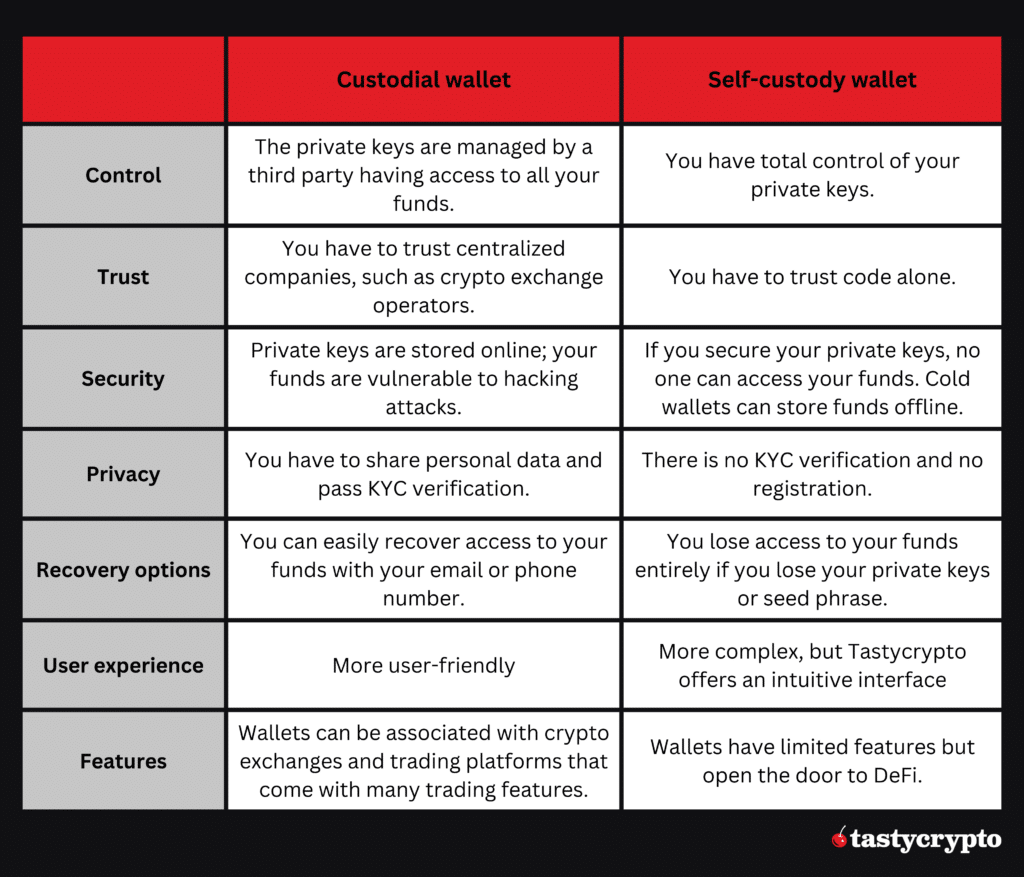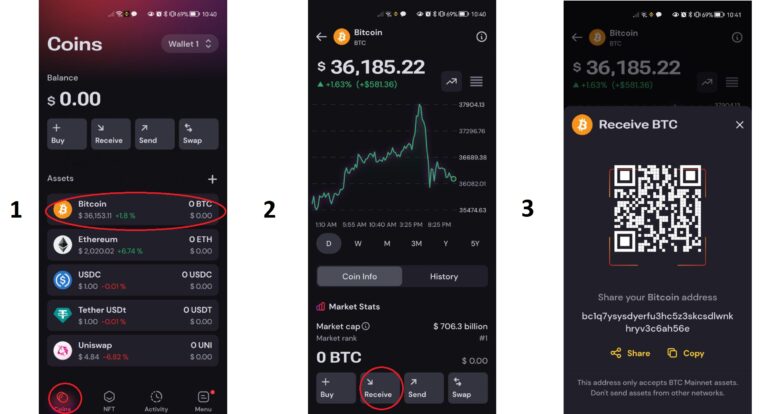The best way to securely store Bitcoin is through self-custody wallets, which provide excellent security and control.
Written by: Anatol Antonovici | Updated August 24, 2024
Reviewed by: Mike Martin
Fact checked by: Ryan Grace

Bitcoin advocate Andreas Antonopoulos coined the phrase “not your keys, not your coins.” While this may seem quite obvious for those using decentralized finance (DeFi) apps, the first wave of Bitcoin adoption was pushed by centralized exchanges (CEXs) like Coinbase and Binance, which hold the private keys of users.
At the time, many people didn’t realize the importance of holding crypto in a non-custodial wallet, also referred to as a self-custody wallet.
Today, non-custodial wallets have become increasingly popular. In this guide, we’ll tell you what they are and show you how to use them.
Table of Contents
🍒 tasty takeaways
Self-custody wallets manage your private keys, granting you total control of your Bitcoin.
You can choose from software wallets for everyday use or hardware wallets for offline storage.
tastycrypto is an easy-to-use mobile app that facilitates self-custody of Bitcoin and altcoins on other blockchain networks.
Summary
| Self-Custody Wallet: | A crypto wallet that gives you full control over your cryptocurrency by storing the private key, ensuring complete ownership and security. |
| Bitcoin Storage: | The most secure way to store Bitcoin is through self-custody wallets, offering excellent security and control over your assets. |
| Wallet Types: | You can choose between software wallets for everyday use and hardware wallets for offline storage, each with its advantages. |
| tastycrypto App: | tastycrypto is a user-friendly mobile app that simplifies self-custody for Bitcoin and altcoins on various blockchain networks. |
| Non-Custodial Wallets: | Non-custodial wallets, like tastycrypto, have gained popularity due to their increased control and security compared to centralized exchanges (CEXs). |
What Is a Bitcoin Wallet?
A Bitcoin wallet (like tastycrypto) serves as a self-custody storage location for bitcoin (BTC). It can take the form of an application, a hardware device, a third-party service, or even a physical piece of paper.
Self-custody wallets, which are also known as Web3 wallets, don’t hold Bitcoin itself, but rather a pair of keys – cryptographic information necessary for accessing cryptocurrency addresses and conducting transactions. These keys track your bitcoin holdings on the Bitcoin blockchain.
There are two types of keys that a wallet can store:
- Public key – this is the public address that can be shared with anyone to receive BTC, akin to the 16-digit number on your bank card.
- Private key – the public key is paired with a private key, which gives you access to the crypto stored on that address. Ideally, it shouldn’t be shared with anyone. It’s like the 4-digit PIN of your debit card.
What is a Self-Custody Wallet?
A self-custody wallet is a crypto wallet that gives you full control over your crypto holdings by storing the private key, which is the code that proves that you are the owner of your crypto.
Self-custody wallets differ from custodial wallets, which manage your cryptocurrency on your behalf. Custodial exchanges (CEXs) like Coinbase retain full control over their users’ private keys, and users access these platforms through accounts. While this setup offers convenience, it also makes custodial wallets and CEXs susceptible to hacking attacks, potentially resulting in the loss of user funds.
To get full control over your Bitcoin and other digital assets, a self-custody wallet is the best choice. In addition to greater security, these wallets open the door to DeFi opportunities.

Types of Self-Custody Wallets
There are two types of self-custody crypto wallets: hot wallets and cold wallets:
- Hot wallets – these are software wallets that can come as a browser extension or a mobile app on Android or iOS. These are the most popular wallets in DeFi and Web3. While hot wallets help you keep the private key with you, they’re always connected to the internet.
Tastycrypto’s self-custody wallet falls under this category – it comes both as a browser extension and as a mobile app. - Cold wallets – these are hardware wallets that can store your cryptocurrency offline. They represent physical devices that can be connected to the internet through the USB port when needed. The most popular cold wallet providers are Ledger and Trezor.
Why Do I Need a Self-Custody Wallet?
Self-custody wallets offer great advantages over custodial ones. Here are some key benefits:
- Control – you have full control over your Bitcoin holdings. Self-custody wallets are censorship-resistant – no third party can freeze or confiscate your funds for whatever reason.
- Security – custodial wallets have been targeted by hackers from day one. On the other side, non-custodial wallets provide more security since the private keys are not stored on a central server.
- Privacy – most self-custody wallets offer greater privacy, as they don’t require you to share personal data or pass through KYC (know your customer) verification. Data leaks have plagued even large companies, such as Facebook and Yahoo. Centralized exchanges cannot guarantee that user data is safe 100%.
- Decentralization – self-custody wallets build on the promise of decentralization. They enable you to store and manage your crypto assets and NFTs without relying on a centralized entity. They also open to the DeFi sector, in which wallet owners can directly interact with decentralized applications (dApps).
How to Self-Custody Bitcoin?
If you hold a large amount of Bitcoin, the best option would be to buy a hardware wallet like Ledger Nano S Plus, which can store Bitcoin and hundreds of altcoins.
However, the most straightforward approach to self-custody is to choose a software wallet, which is easier to use for everyday operations.
Aside from tastycrypto, some popular options are MetaMask, Coinbase Wallet, and Trust Wallet.
How To Use A Hot Wallet
Here are the steps to use a hot wallet.
- Install wallet – start by downloading the mobile wallet or browser extension and installing it. Make sure you land on the official webpage. Most wallets will require you to create a password for future access.
- Set up recovery phrase – when you install a new wallet, the wallet will generate a recovery phrase (or seed phrase), which represents a sequence of random words (12 or 24) arranged in a specific order. This step can be skipped, but it’s highly recommended to generate the seed phrase right away. It represents the master key and is used to generate other private keys (new addresses) within your wallet. Also, if you break or lose your mobile device, you can use the recovery phrase to unlock access to your wallet on any other device.
- Transfer your Bitcoin – once you have your self-custody installed, you can transfer Bitcoin to it. You can copy the public address and use it to transfer from your custodial wallet. Alternatively, you can buy crypto within the wallet using services like PayPal.
Self-Custody with tastycrypto
tastycrypto offers an easy-to-use mobile wallet that can be installed on Android or iOS. To use it, follow the same steps:
- Download the app on the official site. Create a secure password upon installation.
- Generate the recovery phrase. Store it safely, and don’t share it with anyone!
- Now it’s time to add Bitcoin to your new Tastycrypto wallet. You can do it by tapping on “Coins,” then selecting “Bitcoin,” and then tapping on “Receive.” You will be able to copy your address to move your Bitcoin to it.

Voila! Now your Bitcoin is safe!
FAQs
A self-custody wallet, or a non-custodial wallet, is a cryptocurrency wallet that stores the user’s private key. It gives you complete control over your cryptocurrency.
The best way to self-custody Bitcoin is to use a software wallet like tastycrypto. For better security, you can use a cold wallet.
Non-custodial wallets offer unique benefits, such as full control over the crypto funds, security, privacy, and access to DeFi.
tastycrypto is a great start for beginners. It focuses on Ethereum assets, but it can store Bitcoin as well. Other hot wallets are MetaMask, Trust Wallet, and Coinbase Wallet. Ledger Nano S and Trezor are the most popular hardware wallets.
🍒 tasty reads


The Core Blockchain and DeFi Ecosystem: What You Need to Know

7 Best DePIN Crypto Projects

What Is Symbiotic and How Does It Work in 2024?

Ethereum vs Ethereum ETFs – 5 Major Differences


Anatol Antonovici
6+ years of experience writing for crypto brands and blockchain firms, including Coindesk, Cointelegraph, Bitcoinist, CryptoPotato, Algorand, and OTCTrade.com

